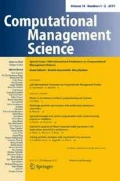Abstract
Index tracking is a passive investment strategy in which a fund (e.g., an ETF: exchange traded fund) manager purchases a set of assets to mimic a market index. The tracking error, i.e., the difference between the performances of the index and the portfolio, may be minimized by buying all the assets contained in the index. However, this strategy results in a considerable transaction cost and, accordingly, decreases the return of the constructed portfolio. On the other hand, a portfolio with a small cardinality may result in poor out-of-sample performance. Of interest is, thus, constructing a portfolio with good out-of-sample performance, while keeping the number of assets invested in small (i.e., sparse). In this paper, we develop a tracking portfolio model that addresses the above conflicting requirements by using a combination of L0- and L2-norms. The L2-norm regularizes the overdetermined system to impose smoothness (and hence has better out-of-sample performance), and it shrinks the solution to an equally-weighted dense portfolio. On the other hand, the L0-norm imposes a cardinality constraint that achieves sparsity (and hence a lower transaction cost). We propose a heuristic method for estimating portfolio weights, which combines a greedy search with an analytical formula embedded in it. We demonstrate that the resulting sparse portfolio has good tracking and generalization performance on historic data of weekly and monthly returns on the Nikkei 225 index and its constituent companies.
























Similar content being viewed by others
Notes
If the optimization software permits, it is better to replace the constraints \(-M y_i \le \pi _i\le M y_i\) with logical constraints \(((\pi _i==0)||(y_i == 1))\), because such BigM formulations (7) including large values of \(M\) sometimes behave in unstable ways.
Normalized means that \(f\) satisfies \(q(\emptyset )=0\).
References
Boer PM, Hafner CM (2005) Ridge regression revisited. Statistica Neerlandica 59(4):498–505
Brodie J, Daubechies I, De Molc C, Giannone D, Loris I (2009) Sparse and stable markowitz portfolios. PNAS 106:12267–12272
Chang T, Meade N, Beasley J, Sharaiha Y (2000) Heuristics for cardinality constrained portfolio optimisation. Comput Oper Res 27:1271–1302
Das A, Kempe D (2008) Algorithms for subset selection in linear regression. In: Proceedings of STOC 2008, pp 45–54
Das A, Kempe D (2011) Submodular meets spectral: Greedy algorithms for subset selection, sparse approximation and dictionary selection. In: Proceedings of international conference on machine learning
Davis G, Mallat S, Zhang Z (1994) Adaptive time-frequency decompositions with matching pursuits. Optic Eng 33(7):2183–2191
DeMiguel V, Garlappi L, Nogales F, Uppal R (2009a) A generalized approach to portfolio optimization: improving performance by constraining portfolio norms. Manag Sci 55:798–812
DeMiguel V, Garlappi L, Uppal R (2009b) Optimal versus naive diversification: How inefficient is the 1/n portfolio strategy? Rev Financ Stud 22(5):1915–1953
Fastrich B, Winker P (2012) Robust portfolio optimization with a hybrid heuristic algorithm. Comput Manag Sci 9(1):63–88
Gilli M, Këllezi E (2002) The threshold accepting heuristic for index tracking. Financial Engineering, E-Commerce, and Supply Chain. Kluwer, Dordrecht, pp 1–18
Gotoh J, Takeda A (2011) On the role of norm constraints in portfolio selection. Comput Manag Sci 8(4):323–353
Hoerl E, Kennard RW (1970) Ridge regression: biased estimation for nonorthogonal problems. Technometrics 12:55–67
Hastie T, Tibshirani R, Friedman J (2008) The elements of statistical learning—data mining, inference, and prediction, 2nd edn. Springer, New York
Konno H, Wijayanayake A (2001) Portfolio optimization problem under concave transaction costs and minimal transaction unit constraints. Math Progr 89(2):233–250
Konno H, Wijayanayake A (2002) Portfolio optimization under d.c. transaction costs and minimal transaction unit constraints. J Glob Optim 22(1–4):137–154
Lobo M, Fazel M, Boyd S (2007) Portfolio optimization with linear and fixed transaction costs. Ann Oper Res 152(1):341–365
Markowitz H (1952) Portfolio selection. J Financ 7(1):77–91
Minoux M (1978) Accelerated greedy algorithms for maximizing submodular set functions. In: Optimization, techniques, pp 234–243
Nemhauser GL, Wolsey LA, Fisher ML (1978) An analysis of approximations for maximizing submodular set functions. Math Program 14:265–294
Pati Y, Rezaiifar R, Krishnaprasad P (1993) Orthogonal matching pursuit: recursive function approximation with application to wavelet decomposition. In: Asilomar conference on signals, systems and computers
Prigent J-L (2007) Portfolio optimization and performance analysis. Chapman& Hall/CRC, Boca Raton
Roll R (1992) A mean/variance analysis of tracking error. J Portf Manag 18(4):13–22
Rudolf M, Wolter HJ, Zimmermann H (1999) A linear model for tracking error minimization. J Bank Financ 23(1):85–103
Ruiz-Torrubiano R, Suárez A (2009) A hybrid optimization approach to index tracking. Ann Oper Res 166(1):57–71
Schölkopf B, Smola A, Williamson R, Bartlett P (2000) New support vector algorithms. Neural Comput 12(5):1207–1245
Takeda A, Gotoh J, Sugiyama M (2010) Support vector regression as conditional value-at-risk minimization with application to financial time-series analysis. In: Proceedings of 2010 IEEE international workshop on machine learning for signal processing
Tibshirani R (1996) Optimal reinsertion: regression shrinkage and selection via the lasso. J R Stat Soc Ser B 58(1):267–288
Woodside-Oriakhi M, Lucas C, Beasley J (2011) Heuristic algorithms for the cardinality constrained efficient frontier. Eur J Oper Res 213:538–550
Xu F, Xu Z, Xue H (2011) Sparse index tracking: an l1/2 regularization based model and solution. http://gr.xjtu.edu.cn:8080/LiferayFCKeditor/UserFiles/File/NewAOR.pdf
Yen Y, Yen T (2011) Solving norm constrained portfolio optimizations via coordinate-wise descent algorithms. Technical report, London School of Economics and Political Science, UK
Zhang T (2008) Adaptive forward-backward greedy algorithm for sparse learning with linear models. In: Advances in Neural Information Processing Systems, vol 22, pp 1921–1928
Author information
Authors and Affiliations
Corresponding author
Rights and permissions
About this article
Cite this article
Takeda, A., Niranjan, M., Gotoh, Jy. et al. Simultaneous pursuit of out-of-sample performance and sparsity in index tracking portfolios. Comput Manag Sci 10, 21–49 (2013). https://doi.org/10.1007/s10287-012-0158-y
Received:
Accepted:
Published:
Issue Date:
DOI: https://doi.org/10.1007/s10287-012-0158-y




